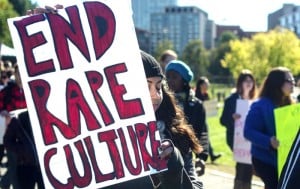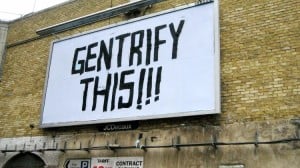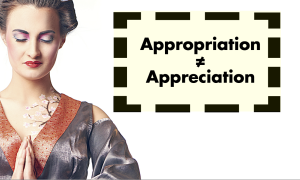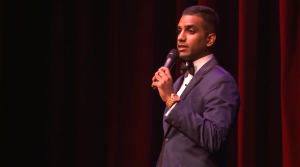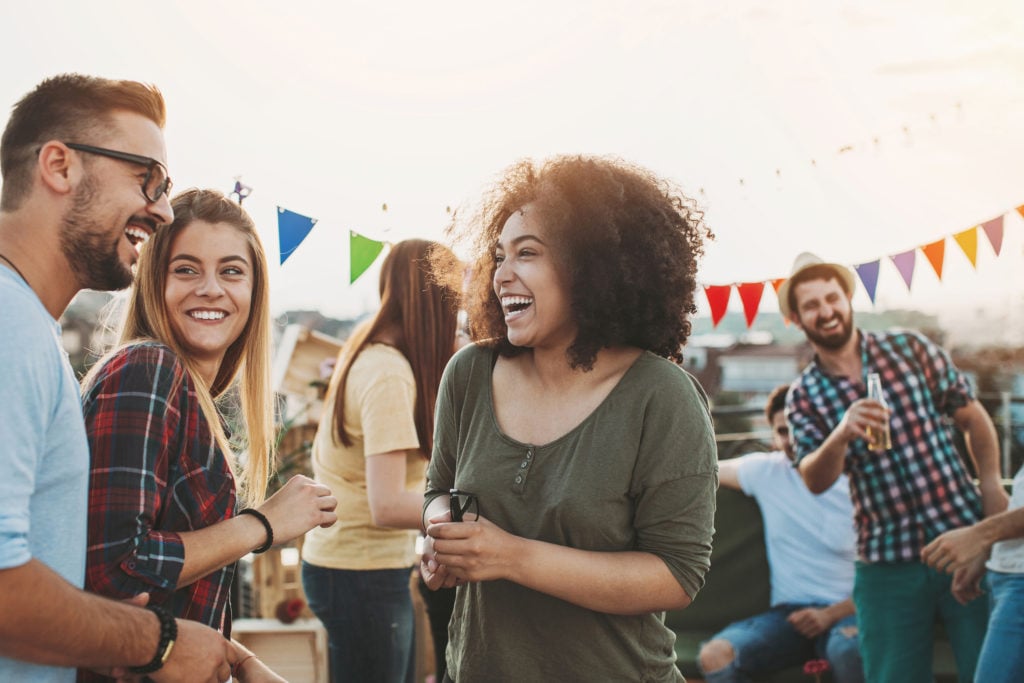
People at an outdoor party.
I have bought so many tickets, and RSVP’d to so many events, that I could not attend.
Another $30 down the drain. This time it was after finding out that the event would not have seating that was accessible to me. I cried as I resigned myself to spending the entire day in bed—again!
I couldn’t help but feel betrayed by my community. Another inaccessible event. Does anyone care that I am not there?
Let me rewind. I have chronic illnesses which often make it difficult for me to attend events. Sometimes, no matter how accessible the event, I am too sick to go. However, there are many other times that I could attend if the event were more accessible to me.
I miss being able to participate in so many things due to a lack of accessibility. Loneliness and isolation are such a huge part of having chronic illnesses, but it doesn’t have to be this way (or at least to this level).
Accessibility is often reduced to wheelchair accessibility which is only part of what accessibility requires. (Though many events are still not accessible for wheelchair users either, which is absolutely inexcusable.)
After talking with some friends with chronic illnesses, we came up with some ideas that will help you make your next event more accessible to people with chronic illnesses. Here they are, in no particular order:
1. Make sure seating is available and accessible.
When I asked my sick friends about accessibility, seating was one of the first things that people mentioned. There are lots of things to think about with seating beyond whether or not it is available. As I mentioned above, seating can make or break many people’s ability to attend an event.
Seating also needs to be padded and comfortable enough for people with chronic pain issues, large and sturdy enough (and without armrests) so it is suitable for all bodies and arranged in a way that makes it easy for scooters, wheelchairs, and other mobility aids to navigate easily.
Part of the fun of events is spending time with friends so it’s important to have places for friends and caregivers to sit. In addition, there should be no additional charge for seating, places to even lay down comfortably if possible, and seating/laying spaces reserved for people with disabilities if space is limited.
Look, I understand that planning events on a budget means that you can’t necessarily implement all of these ideas (and the ones that follow). However, if you keep them in the forefront of your planning, and are willing to be creative, you will be able to make your event more accessible.
It will take work and a little bit of money, but (especially for social justice focused events), if it is not accessible then it is not inclusive or revolutionary.
One friend who uses a wheelchair mentioned that one of her biggest problems is that even when the venue itself is accessible, people will stop and socialize in hallways which makes it hard for her to get through and she is easily exhausted by having to tell people to move.
So there should also be signs posted access corridors where people are not allowed to congregate so that people using wheelchairs, walkers, or other devices can easily navigate the hallways without having to use lots of energy (and awkwardness) asking people to move all the time.
2. Think about ticket prices and cancellation policy.
I have to constantly cancel events due to my illnesses to the point that I don’t buy tickets in advance anymore unless there is a generous refund policy (after learning from the above situation!).
Making tickets refundable up until the event starts can help sick people plan to go but not lose money if we are unable to go at the last minute.
Ticket prices should also be kept low or sliding scale (without requiring proof of income as that is just one more barrier for those of us with limited bandwidth) as chronic illness can have a huge effect on income level.
Many of us cannot work at all or can only work limited hours which means that our income is nonexistent or limited.
3. Don’t forget about bathrooms!
Bathrooms need to be truly wheelchair accessible and large enough for fat people with wheelchairs to navigate. Just because a bathroom says it’s wheelchair accessible does not necessarily mean it is or that a wheelchair user will have privacy in the bathroom.
The bathroom should also include grab bars. Bathrooms should be close to the events taking place as a long trek to the bathroom can be inaccessible. My illnesses require lots of bathroom use and if the bathroom is hard to get to I end up missing much of the event.
Bathrooms also should have fragrance free soap, no air fresheners, and there should be plenty of gender-neutral bathrooms so sick nonbinary and other folks who prefer gender-neutral bathrooms don’t have to go to the ends of the earth just to pee.
4. Location and timing are important.
The location of the event is also super important to accessibility. The location should be somewhere that is easy to get to by public transportation. There also should be disabled parking that is close to the entrance.
The distance between drop off/parking and the event entrance should be as flat as possible and if it is not then that should be noted in the event information. Also, the distance from drop off to the event itself should be noted specifically (e.g. 500 feet, half a mile, etc.).
Timing is also huge as many of us cannot attend nighttime events and do better with earlier events (say 6 pm instead of 10). However, other sick people have a hard time getting up in the morning and may prefer events later in the day. I know this sounds like a catch-22, but moving events around can help more people go.
For example, a 4 pm dance party or a 3 pm lunch meeting may sound strange, but you may also end up with a much bigger crowd by making it more accessible for sick people and others with non-traditional preferences. (As I get older even the nondisabled people around me are asking for earlier events so I think you may be surprised at the kind of turnout these events can get.)
Likewise, a location that may be convenient for one person may not be convenient for another person so changing the place and time of ongoing events can help make it more accessible.
For smaller events with a set guest list, you should try to accommodate sick people as able-bodied people generally have an easier time traveling.
It does not need to be “fair” in that it is the same distance for everyone, but rather it should be equitable meaning that the people with the most ability to travel are the ones doing the most traveling.
Whether an event is indoor or outdoor can also make a huge difference in accessibility. Many people with illnesses are photophobic which makes being in the sun impossible.
Outdoor locations can be difficult for wheelchair and other assistive device users due to gravel, sand, and other less than sturdy surfaces. Conversely, for some people outside works better due to fragrance or other issues.
5. Provide quiet space if you can.
Lots of people—disabled and not—can benefit from a quiet room slightly apart from the event as a place to rest, relax, decompress, take medicine, take a sensory or social break, or other reasons.
Ideally, the quiet place will also have places for people to lay down for naps and low lighting to help with sensory overload. Also outlets for charging phones and other devices.
While headphones should be used if there is noise coming from devices, electronics are often related to access that it’s also important for devices to not be policed.
Relatedly, people should also be allowed to bring in backpacks and anything else that helps to make the experience accessible as long as it does not interfere with access to someone else. The volume of the event itself should also be thought about.
If the event is primarily a social one then music should be kept low enough to not be distracting to people having conversations. If it is a spectator event then it should be loud enough for everyone to hear, but not so loud that it causes sensory overload.
People are different and there is always a balance that may include some people but exclude others. Using creativity we can hopefully find solutions to any issues that come up. For example, if it’s too loud for someone then maybe noise-canceling headphones can be used, etc. With all of this, creativity is key!
6. If there is going to be food, be transparent.
Food is tricky because there is such a wide variety of ways to eat. If you are offering food (whether for free or for sale) at a minimum you should list ALL of the ingredients so people know what they can eat.
Ideally, you will also have foods that are variously vegetarian, vegan, meat, halal, kosher, gluten-free, nondairy, not processed, etc. While this can be impossible, letting people know what food is there ahead of time and allowing outside food and drink to be brought in can help make sure that everyone has something to eat.
7. Consider making your event fragrance free.
It is so common for people with chronic illnesses to also have some kind of scent sensitivity. It is not enough for there to be a low or no scent policy, the policy also needs to be enforced.
I made a lot of mistakes when I first tried to be scent free and accidentally put friends at risk of migraines, pain, and other exacerbations of symptoms. Leah Lakshmi Piepzna-Samarasinha’s Fragrance-Free Femme of Colour Genius guide is very helpful for people (and events) new to being fragrance-free.
This also means that the bathroom soap needs to be fragrance-free and there is no air freshener in the bathroom or anywhere else. Also cleaning products throughout the space should be evaluated for potential for reactions and cleaning with harsh chemicals should be done as far in advance of the event as possible.
If the event needs to include things like smudging, incense, scented candles or other fragrances think about whether it is possible to do this part outside or at the end of the event where people who are unable to be around scents can leave beforehand (though keep in mind this may feel shitty to people who wanted to attend the whole event).
8. Disabled people should not be an afterthought in safety planning.
Sick and disabled people cannot be afterthoughts when it comes to safety. Emergency exits need to be accessible and there needs to be a fire safety plan in place that includes people who use wheelchairs.
When planning the layout of an event make sure that all accessibility devices are taken into account and understand that some bodies cannot move as fast or as agilely as others.
9. Make sure to include accessibility with the event information.
If you don’t mention accessibility in the event info then we will all assume it is not accessible and not attend. Accessibility information lets people know that you value disabled people enough to make it so we can attend your event.
It’s also important to provide contact information so that we can ask questions about accessibility or make requests. Even if an event is not accessible, it’s so much better to know beforehand than to waste energy trying to go somewhere and not have it work out.
10. Other things to think about.
There are other things that can help increase accessibility for people who have illnesses that may not be directly related to their disabilities, like on-site free childcare. Skype or live stream options for people who can’t attend in person can help make those of us not able to be there feel included.
ASL interpreters, captioning for videos, and image descriptions for people with low or no sight can help blind and deaf have greater access (some of whom also have chronic illnesses).
Other great ideas are people who are designated to help meet the needs of disabled people (e.g. someone who will refill water bottles or get food), and trigger warnings with the most likely triggering stuff being after a break or another time when people with mobility aids can remove themselves less conspicuously.
Of course like disability itself, the effects of chronic illnesses vary between people and illnesses so what may work for one person may not work for others. Conversely, many of the things on here will also help make your event more accessible to people who aren’t sick.
In the end, the choices that are made when organizing an event will determine who is able to be there and who isn’t. If you want a truly inclusive event you need to cast the widest net of inclusivity and hopefully, these ideas will help you to make your event more accessible.
Thank you to Margarita Carnero, Briana Cavanaugh, Becka Gorelick, Heather Douglass, Felicia Jade, MN Munson, Alaina Leary, Sara Hickman-Himes, Joy Armstrong, Naomi Stein, Leslie Nickerson, Greg Halpern, Marisa Leigh, Emily Drennen, Susan M. Taylor, Jess Posner, Melissa Lesley-Fox, and Brenda Hart Neihouse for their ideas and willingness to share!
[do_widget id=’text-101′]
Katie Tastrom is an activist, writer, and lawyer. She writes about living with chronic illnesses, disability justice, fatness, parenting, queerness, bodies, and other stuff. She lives in Syracuse, NY with her four kids and amazing partner. She also watches a lot of TV. You can find more at katietastrom.com or follow her on Twitter at @katietastrom.
Search our 3000+ articles!
Read our articles about:
Our online racial justice training
Used by hundreds of universities, non-profits, and businesses.
Click to learn more
Most Read Articles
- « Previous
- 1
- …
- 30
- 31
- 32






